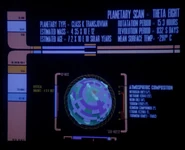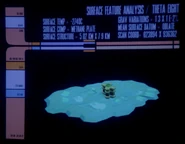(Added units to the temperature and fixed the exponent on the planet's age.) |
Archer4real (talk | contribs) No edit summary Tag: VE: Source |
||
| (27 intermediate revisions by 12 users not shown) | |||
| Line 1: | Line 1: | ||
| − | {{sidebar planet |
+ | {{sidebar planet |
| − | | |
+ | |name = Theta VIII |
| − | | |
+ | |orbital = Theta 116 VIII, remastered.jpg |
| − | | |
+ | |ocaption = Theta 116 VIII |
| − | | |
+ | |surface = Theta VIII surface.jpg |
| − | | |
+ | |scaption = Theta VIII surface |
| − | | |
+ | |class = [[class K planet|K (transjovian)]] |
| − | | |
+ | |type = [[Planet]] |
| − | | |
+ | |location = [[Theta 116 solar system|Theta 116]] [[star system|system]]<br/>[[Alpha Quadrant|Alpha]] or [[Beta Quadrant]] |
| + | |status = Intact |
||
| + | |datestatus = 2365 |
||
}} |
}} |
||
| ⚫ | '''Theta VIII''' (or '''Theta Eight''') was the [[uninhabited planets|uninhabited]] [[eighth planets|eighth]] [[planet]] of the [[Theta 116 system]]. This world had an [[ |
||
| ⚫ | '''Theta VIII''' (or '''Theta Eight''') was the [[uninhabited planets|uninhabited]] [[eighth planets|eighth]] [[planet]] of the [[Theta 116 solar system]]. This world had an [[orbital period]] of 832 [[day]]s, and a rotational period of 15.3 [[hour]]s. A [[Class K planet|K-class transjovian]] planet, the [[atmosphere]] of Theta 116 VIII was composed of [[nitrogen]] (57%), [[methane]] (23%), [[liquid]] [[neon]] (14%), [[yurium]] (2%), [[keimium]] compounds (2%), [[ethane]] (1%), and [[tormium]] (trace). The mean [[surface temperature]] was [[temperature|−291]] [[Celsius|°C]], with [[wind]] [[speed]]s of up to 320 [[meters per second]]. Interesting [[weather]] [[phenomenon|phenomena]] included [[ammonia]] [[tornado]]es. Its age was estimated at [[Distant past|7.2{{exp|10}} solar years]], and during that time it had built up a [[mass]] of 4.35{{exp|12}}. |
||
| ⚫ | In the [[21st century]], the [[NASA]] spacecraft ''[[Charybdis]]'' was brought on orbit by an [[alien|unknown intelligence]] which had inadvertently killed all but one of its crew, [[Colonel]] [[Stephen G. Richey]]. The intelligence attempted to create an environment for him where he could live, in the form of a small pocket of [[Earth]]-like atmosphere on the surface. In it was the entryway to a replica of the [[Royale|namesake hotel]] from the [[novel]] ''[[Hotel Royale]]'' carried by Richey. |
||
| + | {{bginfo|No unit was specified for the planet's mass. See also ''background information''.}} |
||
| ⚫ | Richey lived in room 727 of the hotel until he died in his sleep in [[2082]]. The hotel was located on a plane of frozen methane with the dimensions of 5.02 × 7.9 [[kilometer]]s, in the middle of a tremendous storm belt, described as like being in the "eye of a [[hurricane]]." The Hotel itself had the following dimensions: 127 × 53 × 244 [[meter]]s. |
||
| ⚫ | In the [[21st century]], the [[NASA]] [[spacecraft]] ''[[Charybdis]]'' was brought on [[orbit]] by an [[alien|unknown intelligence]] which had inadvertently killed all but one of its [[crew]], [[Colonel]] [[Stephen G. Richey]]. The intelligence attempted to create an environment for him where he could live, in the form of a small pocket of [[Earth]]-like atmosphere on the [[surface]]. In it was the entryway to a replica of the [[Royale|namesake hotel]] from the [[novel]] ''[[Hotel Royale]]'' carried by Richey. |
||
| ⚫ | Remains of the ''Charybdis'' were detected by a [[Klingon cruiser]] in [[2365]]. They were found to have molecular disintegration similar to those caused by [[24th century]]-level weapon impacts. The {{USS|Enterprise|NCC-1701-D|-D}} investigated the planet and discovered Richey's fate. ({{TNG|The Royale}}) |
||
| + | |||
| ⚫ | Richey lived in [[room]] 727 of the hotel until he [[died]] in his [[sleep]] in [[2082]]. The hotel was located on a plane of frozen methane with the dimensions of 5.02 × 7.9 [[kilometer]]s, in the middle of a tremendous storm belt, described as like being in the "eye of a [[hurricane]]." The Hotel itself had the following dimensions: 127 × 53 × 244 [[meter]]s. |
||
| + | |||
| ⚫ | Remains of the ''Charybdis'' were detected by a [[Klingon]] [[Klingon 24th cruiser 001|cruiser]] in [[2365]]. They were found to have molecular disintegration similar to those caused by [[24th century]]-level weapon impacts. The {{USS|Enterprise|NCC-1701-D|-D}} investigated the planet and discovered Richey's fate. ({{TNG|The Royale}}) |
||
<gallery> |
<gallery> |
||
| − | File:Theta 116 VIII graphic.jpg|Planetary scan |
+ | File:Theta 116 VIII graphic.jpg|Planetary scan – Theta eight |
| − | File:Methane Plane and The Royale.jpg|Surface feature analysis |
+ | File:Methane Plane and The Royale.jpg|Surface feature analysis – Theta eight |
</gallery> |
</gallery> |
||
| + | == Appendices == |
||
| ⚫ | |||
| + | === Background information === |
||
| ⚫ | |||
| + | |||
| + | The physical parameters of Theta VIII as seen on the planetary scan-[[okudagram]] included several curiosities: |
||
| + | * According to real-world [[physics]], [[absolute zero]] is defined as −273 °C, making Theta VII's mean surface temperature of −291 °C impossible. ('''Note''': In the episode's {{st-minutiae|resources/scripts/138.txt|script}}, −291 °[[Fahrenheit]] was used, i.e., about −179 °C.) |
||
| + | * If we assume "solar years" imply Earth years, the planet's age of 7.2{{exp|10}} (72 billion) solar years surpasses the [[Billions of years ago|age of the universe]] by a factor of approximately five. Using Theta VIII's given orbital period of 832 days would even imply the planet to be roughly ten times older than the [[universe]]. |
||
| + | * If the planet's mass of 4.35{{exp|12}} was meant to be in [[kilogram]]s or {{w|metric ton}}s, it would be extremely low and correspond to only a tiny fraction of [[Earth]]'s mass, or up to twenty times the mass of [[Halley's Comet]]. |
||
| + | |||
| + | A scene ultimately removed from the final version of "The Royale" describes Theta VIII further; "''Ship's log, [[stardate]] 42625.4, [[First Officer]] [[William Riker|Riker]] reporting. We have achieved orbit around Theta Eight ''[...]'' the planet furthest from its [[star|sun]] in this previously unmapped solar system. It is a world of ruthless realities: particularly harsh, barren, and inhospitable.''" {{st-minutiae|resources/scripts/138.txt}} |
||
| + | |||
| + | Before "The Royale", two other Theta planets have been mentioned in Star Trek. [[Theta III]] seen on [[:File:The Explored Galaxy.jpg|a star chart]] and [[Theta VII]], a [[colony]] planet, where {{USS|Enterprise|NCC-1701}} delivered [[vaccine]]s after the events in {{TOS|Obsession}} set in [[2265]]. |
||
| − | ==External |
+ | === External links === |
| − | * {{ |
+ | * {{mbeta|Theta 116 VIII}} |
| + | * {{eas|/inconsistencies/tng_planets.htm|Re-Used Planets in TNG|external}} |
||
[[de:Theta 116 VIII]] |
[[de:Theta 116 VIII]] |
||
Latest revision as of 10:42, 1 November 2022
Theta VIII (or Theta Eight) was the uninhabited eighth planet of the Theta 116 solar system. This world had an orbital period of 832 days, and a rotational period of 15.3 hours. A K-class transjovian planet, the atmosphere of Theta 116 VIII was composed of nitrogen (57%), methane (23%), liquid neon (14%), yurium (2%), keimium compounds (2%), ethane (1%), and tormium (trace). The mean surface temperature was −291 °C, with wind speeds of up to 320 meters per second. Interesting weather phenomena included ammonia tornadoes. Its age was estimated at 7.2×1010 solar years, and during that time it had built up a mass of 4.35×1012.
In the 21st century, the NASA spacecraft Charybdis was brought on orbit by an unknown intelligence which had inadvertently killed all but one of its crew, Colonel Stephen G. Richey. The intelligence attempted to create an environment for him where he could live, in the form of a small pocket of Earth-like atmosphere on the surface. In it was the entryway to a replica of the namesake hotel from the novel Hotel Royale carried by Richey.
Richey lived in room 727 of the hotel until he died in his sleep in 2082. The hotel was located on a plane of frozen methane with the dimensions of 5.02 × 7.9 kilometers, in the middle of a tremendous storm belt, described as like being in the "eye of a hurricane." The Hotel itself had the following dimensions: 127 × 53 × 244 meters.
Remains of the Charybdis were detected by a Klingon cruiser in 2365. They were found to have molecular disintegration similar to those caused by 24th century-level weapon impacts. The USS Enterprise-D investigated the planet and discovered Richey's fate. (TNG: "The Royale")
Appendices
Background information
In the original (un-remastered) episode, the planet model for Theta VIII was first used for Angel I in "Angel One". It was used again for Minos in "The Arsenal of Freedom" and again for Legara IV in "Sarek".
The physical parameters of Theta VIII as seen on the planetary scan-okudagram included several curiosities:
- According to real-world physics, absolute zero is defined as −273 °C, making Theta VII's mean surface temperature of −291 °C impossible. (Note: In the episode's script, −291 °Fahrenheit was used, i.e., about −179 °C.)
- If we assume "solar years" imply Earth years, the planet's age of 7.2×1010 (72 billion) solar years surpasses the age of the universe by a factor of approximately five. Using Theta VIII's given orbital period of 832 days would even imply the planet to be roughly ten times older than the universe.
- If the planet's mass of 4.35×1012 was meant to be in kilograms or metric tons, it would be extremely low and correspond to only a tiny fraction of Earth's mass, or up to twenty times the mass of Halley's Comet.
A scene ultimately removed from the final version of "The Royale" describes Theta VIII further; "Ship's log, stardate 42625.4, First Officer Riker reporting. We have achieved orbit around Theta Eight [...] the planet furthest from its sun in this previously unmapped solar system. It is a world of ruthless realities: particularly harsh, barren, and inhospitable." [1]
Before "The Royale", two other Theta planets have been mentioned in Star Trek. Theta III seen on a star chart and Theta VII, a colony planet, where USS Enterprise delivered vaccines after the events in TOS: "Obsession" set in 2265.
External links
- Theta 116 VIII at Memory Beta, the wiki for licensed Star Trek works
- Re-Used Planets in TNG at Ex Astris Scientia


